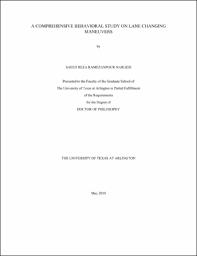
ATTENTION: The works hosted here are being migrated to a new repository that will consolidate resources, improve discoverability, and better show UTA's research impact on the global community. We will update authors as the migration progresses. Please see MavMatrix for more information.
Show simple item record
| dc.contributor.advisor | mattingly, stephen | |
| dc.creator | Ramezanpour Nargesi, Saeed Reza | |
| dc.date.accessioned | 2021-06-03T20:18:58Z | |
| dc.date.available | 2021-06-03T20:18:58Z | |
| dc.date.created | 2019-05 | |
| dc.date.issued | 2019-05-22 | |
| dc.date.submitted | May 2019 | |
| dc.identifier.uri | http://hdl.handle.net/10106/29895 | |
| dc.description.abstract | Since changing lanes might cause traffic congestion and car crashes, the investigation on different aspects of this behavior remains critical. In the past decades, most of lane changing behavior studies have continued to model this behavior mathematically. Lack of qualitative studies in traffic flow theory concepts, especially lane changing behavior is noticeable. This study tries to conduct a comprehensive view of lane changing behavior maneuvers with consideration and analysis the steps of the lane changing process. The author uses the mixed methodological approach to understand the factors which may cause drivers to change lane. After understanding the reasons that make drivers change lanes, the actions of vehicles which are involved in lane changing are investigated using naturalistic driving and stated preference data sets. The target vehicle (the vehicle which executes lane changing), the lag vehicle (the vehicle which is behind the target vehicle when lane changing is completed) and the lead vehicle (the vehicle which is in front of the target vehicle when lane changing is completed) are considered as the main vehicles which are involved in the lane changing maneuver. The stated and revealed preferences of drivers’ actions when they are in target, lead and lag vehicle positions are compared using statistical hypothesis tests. The application of this study is used for calibrating lane changing models. Lastly, this study introduces a methodological game theoretic model of merging and discretionary lane changing behavior. The lag and the target vehicles are considered as the main players of the game. The interactions of these players during the lane changing process is investigated with a game theoretical approach. This section of the study aims to introduce a more realistic model of merging and discretionary lane changing in a single framework which considers the actions of target and lag vehicle based on previous phase of the study. Overall, this dissertation explores lane changing behavior from the view of the decision-making process to introduce a joint merging and discretionary lane changing model. | |
| dc.format.mimetype | application/pdf | |
| dc.language.iso | en_US | |
| dc.subject | Lane changing behavior, Mixed methodological approach | |
| dc.title | A COMPREHENSIVE BEHAVIORAL STUDY ON LANE CHANGING MANUEVERS | |
| dc.type | Thesis | |
| dc.degree.department | Civil Engineering | |
| dc.degree.name | Doctor of Philosophy in Civil Engineering | |
| dc.date.updated | 2021-06-03T20:18:58Z | |
| thesis.degree.department | Civil Engineering | |
| thesis.degree.grantor | The University of Texas at Arlington | |
| thesis.degree.level | Doctoral | |
| thesis.degree.name | Doctor of Philosophy in Civil Engineering | |
| dc.type.material | text | |
Files in this item
- Name:
- RAMEZANPOURNARGESI-DISSERTATIO ...
- Size:
- 4.271Mb
- Format:
- PDF
This item appears in the following Collection(s)
Show simple item record


